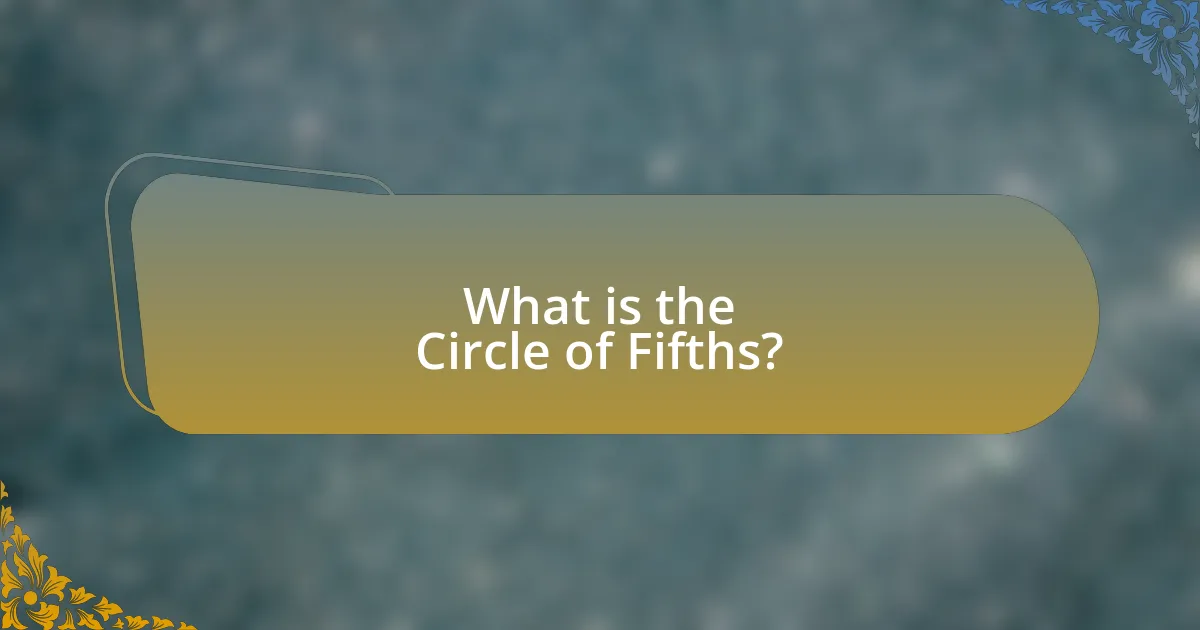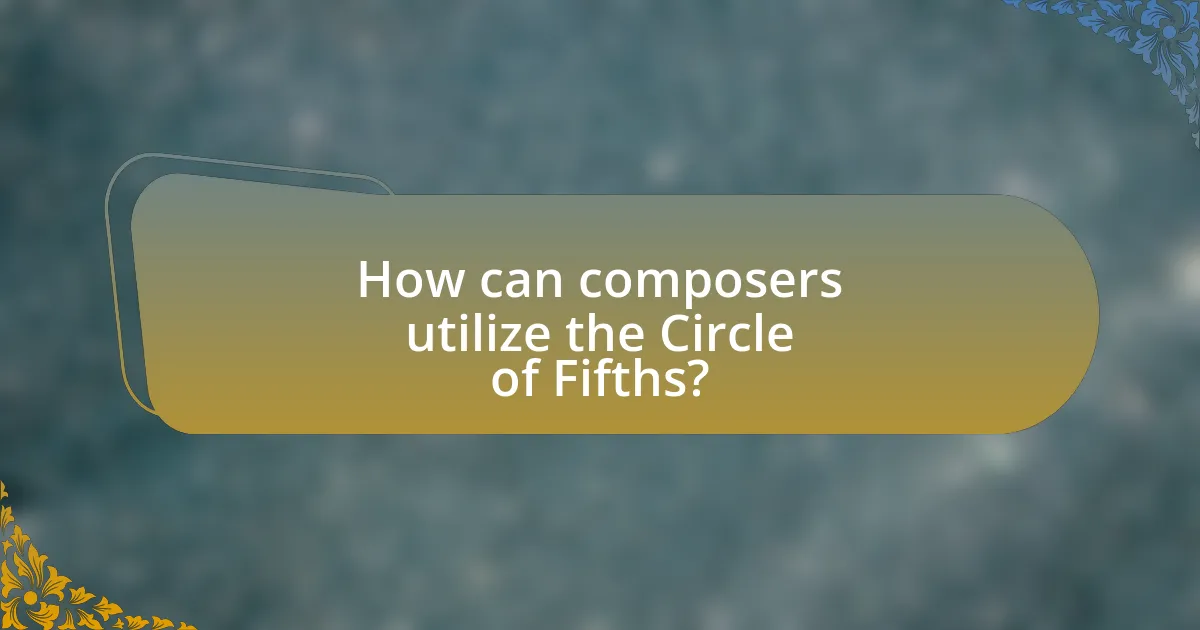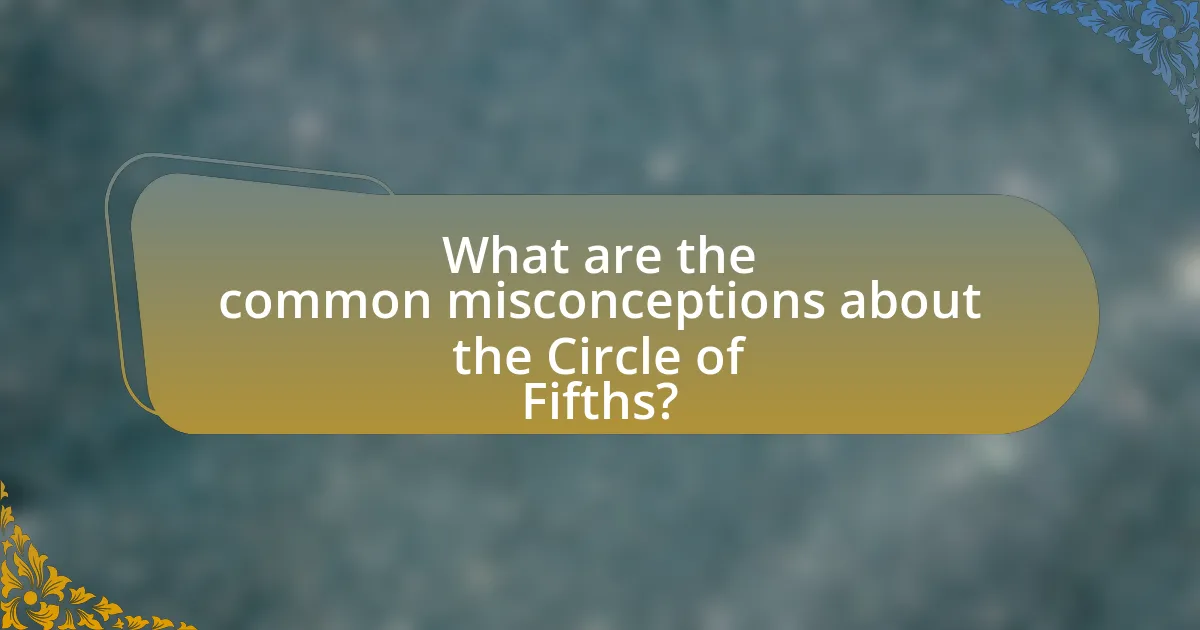The Circle of Fifths is a fundamental concept in music theory that visually represents the relationships between the twelve tones of the chromatic scale, their key signatures, and associated major and minor keys. This article provides a comprehensive overview of the Circle of Fifths, detailing its construction, key elements, and significance for composers. It explores how the Circle aids in understanding key signatures, facilitates chord progressions, and enhances creativity in composition. Additionally, the article addresses common misconceptions, limitations, and best practices for mastering the Circle of Fifths, along with resources for further learning.

What is the Circle of Fifths?
The Circle of Fifths is a visual representation of the relationships between the twelve tones of the chromatic scale, their corresponding key signatures, and the associated major and minor keys. It organizes these keys in a circular format, where each key is a perfect fifth apart from its neighbors, facilitating the understanding of key signatures and chord progressions. This concept is foundational in music theory, as it helps composers and musicians identify relationships between keys, making it easier to compose and transpose music.
How is the Circle of Fifths constructed?
The Circle of Fifths is constructed by arranging the twelve tones of the chromatic scale in a circular format, where each tone is a perfect fifth apart from its neighbors. Starting from C at the top, the sequence progresses clockwise through G, D, A, E, B, F♯, C♯, G♯, D♭, A♭, E♭, and B♭, returning to C. This arrangement reflects the relationships between key signatures, with each step clockwise adding one sharp and each step counterclockwise adding one flat, thus illustrating the harmonic relationships in Western music theory.
What are the key elements of the Circle of Fifths?
The key elements of the Circle of Fifths include the arrangement of the 12 pitches of the chromatic scale in a circular format, where each pitch is a perfect fifth apart. This structure helps musicians understand key signatures, with each step clockwise representing an increase in sharps and each step counterclockwise representing an increase in flats. Additionally, the Circle of Fifths illustrates the relationships between major and minor keys, showing that each major key has a relative minor key located a minor third below it. This framework is essential for composers and musicians for key modulation and harmonic progression.
How do the fifths relate to musical keys?
Fifths relate to musical keys by establishing the relationships between different keys in the Circle of Fifths, which organizes keys based on their intervallic distance of a perfect fifth. Each key is a fifth apart from its neighbors, meaning that moving clockwise around the circle adds sharps to the key signature, while moving counterclockwise adds flats. For example, C major has no sharps or flats, G major (a fifth above) has one sharp, and F major (a fifth below) has one flat. This systematic arrangement helps composers understand key relationships, modulation, and harmonic progression, making it a fundamental tool in music theory.
Why is the Circle of Fifths important for composers?
The Circle of Fifths is important for composers because it provides a visual representation of the relationships between different keys, facilitating key modulation and harmonic progression. This tool helps composers understand how to transition smoothly between keys, which is essential for creating cohesive musical pieces. Additionally, the Circle of Fifths outlines the order of sharps and flats in key signatures, aiding composers in quickly identifying the tonal center and structure of their compositions. By utilizing this framework, composers can enhance their creativity and efficiency in writing music.
How does it aid in understanding key signatures?
The Circle of Fifths aids in understanding key signatures by visually representing the relationships between different keys. This diagram organizes keys in a circular format, showing how many sharps or flats each key has, which helps musicians quickly identify and transition between key signatures. For example, moving clockwise from C major adds sharps, while moving counterclockwise adds flats, making it easier to grasp the structure of Western music theory. This systematic approach enhances comprehension of key signatures, facilitating better composition and performance.
What role does it play in chord progressions?
The Circle of Fifths plays a crucial role in chord progressions by illustrating the relationships between different keys and chords. It helps composers understand how to transition smoothly between chords, facilitating the creation of harmonic progressions that are musically coherent. For example, moving clockwise on the Circle of Fifths typically leads to a progression that feels natural and resolves effectively, as it follows the pattern of dominant to tonic chords. This concept is supported by the fact that many classical and contemporary compositions utilize these relationships to enhance musical tension and resolution, making the Circle of Fifths an essential tool for composers.

How can composers utilize the Circle of Fifths?
Composers can utilize the Circle of Fifths to understand key signatures and relationships between chords, facilitating smoother transitions and modulations in their compositions. By following the Circle, composers can easily identify the five sharps or flats in each key, which aids in composing music that flows harmonically. Additionally, the Circle helps in creating chord progressions, as composers can select chords that are closely related, enhancing the overall coherence of the piece. This method is supported by music theory, which shows that adjacent keys on the Circle share many common tones, making them more compatible for modulation and thematic development.
What techniques can be applied using the Circle of Fifths?
The Circle of Fifths can be applied using techniques such as modulation, chord progression, and key signature identification. Modulation involves shifting from one key to another, often utilizing the adjacent keys on the Circle for smooth transitions. Chord progression techniques include creating sequences that move through the circle, enhancing harmonic movement and tension. Additionally, the Circle aids in identifying key signatures, allowing composers to quickly determine the sharps or flats in a given key, which is essential for composition and arrangement. These techniques are foundational in music theory and composition, as they facilitate a deeper understanding of relationships between keys and chords.
How can modulation be achieved through the Circle of Fifths?
Modulation can be achieved through the Circle of Fifths by utilizing the relationships between keys that are a fifth apart. This method allows composers to transition smoothly between different keys by moving clockwise or counterclockwise on the Circle, which highlights closely related keys. For example, moving from C major to G major involves a shift of one fifth, making it a natural modulation that maintains harmonic coherence. The Circle of Fifths illustrates these relationships clearly, enabling composers to identify potential modulation paths effectively.
What are common chord progressions derived from the Circle of Fifths?
Common chord progressions derived from the Circle of Fifths include the I-IV-V-I progression, the ii-V-I progression, and the I-vi-ii-V progression. The I-IV-V-I progression, for example, is foundational in many genres, establishing a strong tonal center. The ii-V-I progression is prevalent in jazz, creating smooth transitions between chords. The I-vi-ii-V progression, often used in pop music, provides a cyclical feel that resolves effectively. These progressions leverage the relationships between chords as outlined in the Circle of Fifths, facilitating harmonic movement and resolution.
How does the Circle of Fifths enhance creativity in composition?
The Circle of Fifths enhances creativity in composition by providing a structured framework for exploring harmonic relationships and key signatures. This tool allows composers to easily identify and transition between related keys, facilitating the development of unique chord progressions and melodies. For instance, the proximity of keys on the Circle indicates which chords naturally complement each other, enabling composers to experiment with unexpected modulations and variations. Additionally, the Circle serves as a visual representation of tonal relationships, inspiring composers to think outside conventional boundaries and explore diverse musical ideas.
What are some examples of famous compositions using the Circle of Fifths?
Famous compositions that utilize the Circle of Fifths include Beethoven’s “Symphony No. 5,” which employs key changes that reflect the circle’s structure, and Bach’s “Prelude in C Major,” which showcases a progression through the circle. Additionally, “Pachelbel’s Canon” is known for its use of a chord progression that aligns with the Circle of Fifths, demonstrating its influence in classical music. These examples illustrate how the Circle of Fifths serves as a foundational tool for composers in creating harmonic progressions.
How can the Circle of Fifths inspire new musical ideas?
The Circle of Fifths can inspire new musical ideas by providing a structured framework for exploring harmonic relationships and chord progressions. This tool allows composers to visualize key signatures and their relative relationships, facilitating the creation of innovative melodies and harmonies. For instance, moving clockwise around the circle introduces composers to closely related keys, which can lead to unexpected modulations and variations in their compositions. Additionally, the Circle of Fifths encourages experimentation with chord substitutions and extensions, enhancing the richness of musical texture. By utilizing this method, composers can break free from conventional patterns and discover fresh musical directions.

What are the common misconceptions about the Circle of Fifths?
Common misconceptions about the Circle of Fifths include the belief that it only applies to major keys and that it is solely a tool for chord progressions. In reality, the Circle of Fifths encompasses both major and minor keys, illustrating their relationships and facilitating modulation. Additionally, while it is useful for understanding chord progressions, it also aids in identifying key signatures and enhancing melodic composition. These misconceptions can limit a musician’s understanding and application of the Circle, which serves as a comprehensive framework for various musical concepts.
Why do some musicians misunderstand its purpose?
Some musicians misunderstand the purpose of the Circle of Fifths because they lack a comprehensive understanding of music theory and its applications. This misunderstanding often stems from a focus on memorization rather than grasping the underlying relationships between keys, chords, and scales. For instance, the Circle of Fifths is designed to illustrate the relationships between different musical keys, helping musicians to navigate key signatures and chord progressions effectively. However, without a solid foundation in how these elements interact, musicians may misinterpret the Circle as merely a tool for transposition rather than a framework for composition and improvisation.
What are the limitations of the Circle of Fifths?
The limitations of the Circle of Fifths include its inability to represent all musical scales and modes, as it primarily focuses on major and minor keys. This means that it does not adequately address the complexities of modal music or non-Western scales, which can lead to a narrow understanding of harmonic relationships. Additionally, the Circle does not account for chromaticism and modern harmonic practices, such as atonality or polytonality, which are prevalent in contemporary music. These factors limit its applicability for composers exploring diverse musical styles beyond traditional Western tonal music.
How can these misconceptions be clarified?
Misconceptions about the Circle of Fifths can be clarified through targeted education and practical application. Educators can provide clear explanations of the Circle’s structure, emphasizing its role in music theory and composition. For instance, demonstrating how the Circle illustrates key signatures and their relationships can help students grasp its utility. Additionally, using real-world examples, such as analyzing compositions that utilize the Circle, reinforces understanding. Research indicates that active engagement with the material, such as composing using the Circle, enhances retention and comprehension, as shown in studies on music education methodologies.
What are the best practices for mastering the Circle of Fifths?
To master the Circle of Fifths, practice regularly by visualizing and playing through the circle in various keys. This method reinforces the relationships between keys and their corresponding major and minor scales. Additionally, utilize mnemonic devices to remember the order of sharps and flats, which aids in quick recall during composition and improvisation. Engaging with music theory exercises that involve transposing melodies and harmonies around the circle further solidifies understanding. Research indicates that consistent practice and application of these techniques enhance musicianship, as evidenced by studies showing improved key recognition and harmonic progression skills among students who actively engage with the Circle of Fifths.
How can regular practice improve understanding of the Circle of Fifths?
Regular practice enhances understanding of the Circle of Fifths by reinforcing the relationships between keys and their corresponding sharps and flats. Through consistent engagement with the Circle, musicians develop a mental map of key signatures, which aids in composition and improvisation. Studies show that repetitive exposure to musical concepts solidifies neural pathways, making it easier to recall and apply this knowledge in various musical contexts. For example, practicing scales and chord progressions that utilize the Circle of Fifths allows composers to internalize these relationships, leading to more fluid and intuitive musical creation.
What resources are available for further learning about the Circle of Fifths?
Books, online courses, and interactive tools are available for further learning about the Circle of Fifths. Notable books include “The Complete Musician” by Steven G. Laitz, which provides a comprehensive understanding of music theory, including the Circle of Fifths. Online platforms like Coursera and Udemy offer courses specifically focused on music theory that cover the Circle of Fifths in detail. Additionally, websites such as musictheory.net provide interactive exercises and visual aids to reinforce learning about the Circle of Fifths. These resources collectively enhance understanding and application of the concept in music composition.


